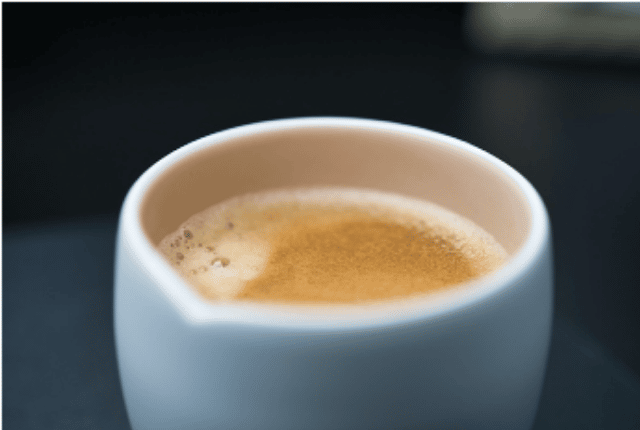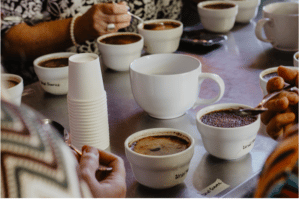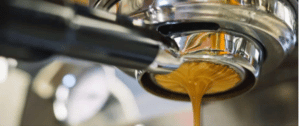
What is crema?
You may have already heard the term “créma” without to know what baristas are talking about. No doubt you have ever been curious to know what makes an espresso sometimes imitate the foaming aesthetic of a beer. What you see, and what all coffee enthusiasts dream of, is called créma and is considered the reference in the preparation of espresso. The thin layer of cream that covers your espresso has a long history and can tell you a lot about the coffee you are going to enjoy! So what si crema?
In simple terms, the crema is what we call the light layer of dark brun foam found on the surface of a cup of espresso. Technically, créma itself has no impact on the taste of the espresso, but coffee experts generally agree that créma is a good indication of the quality of the rest of the espresso.
Crema is formed during the extraction process when water and coffee oils emulsion. After roasting the coffee beans, this begins to release CO2.
Most of it is released into the air between roasting and milling but the CO2 that remains in the cells is released during extraction.
When hot water hits the coffee market with the high pressure of a pressmachine, the water emulsifies the coffee oils and then becomes saturated with CO2, resulting in the formation of many small bubbles that make up the frothy layer of the crema.
A short history of espresso
That said, the crema was not an element of the espresso until 1948 when Achille Gaggia began selling the modern espresso machine, which uses a piston actuated by a lever to push water through thecoffeepot with a higher pressure than was previously possible.
Good or bad crema?
There are a few revealing qualities that determine whether a crema is good or not.
Most importantly, there are a few aesthetic indicators of a poor quality créma, which can be a sign that your espresso is also mediocre.
First, a crema must have a good color balance: a color that is too dark is not a problem but a color that is too light is not desirable. A créma must have a caramelcolor. Then the crema should be smooth. If it is grainy, this can be a problem. Créma relies on thousands of small bubbles to create a foamy but velvety surface. There is no room for large bubbles in a good crema.
A quality crema has a long service lifeideally. A crema that lasts less than a minute may indicate a problem. Most baristas aim to have a créma that takes up about 1/10 of an espresso.
It is important to note that good coffees can produce bad créma and bad coffees can produce good ones. The production of a beautiful créma does not depend only on quality. For example, some Italian coffee companies are infamous for deliberately including Robusta coffee beans in their coffee blend simply because they produce a better coffee.
Arabica is commonly used by specialized roasters for its superior taste and quality, but Robusta produces a richer foam. However, this créma is at the expense of taste! The result is an espresso of a beautiful appearance only. This is one of the many reasons why you will find many coffee experts who encourage you to forget about créma and focus only on making a good espresso at home. There is a good chance that a beautiful crema will follow naturally!
What are the factors that affect the crema?
There are several factors that affect the color, duration, thickness, and overall appearance of the crema. Among these factors are the temperature of the brewing water, the date of roasting of the coffee beans, the duration of extraction and the species of coffee beans used.
A lot of things happen simultaneously in your cup ofpresso. A better way to understand what affects créma and go back: what does the appearance of créma teach you about the espresso you are going to drink?
The three main things you can observe from your crema are color, quality, and lifespan.
The color
There are standard color variations in crema, and not all of them are bad. The colors vary depending on whether the coffee is lighter to darker. However, there are other color variations that signal a problem, such as dark circles on the edge of the cup or too light a crema.
An exceptionally clear crema is a sign that the espresso has been under extract. In this case, the crema can also be finer is not last as long.
When under-extraction is not the problem, a lighter crema can also be the result of a pressmachine thatistoo cold. Check that your machine is still at the ideal temperature for melting (between 90 and 96 degrees).
On the other hand, a crema plus darken is often the result of an over extraction of coffee. This is essentially the opposite problem to that of the clearer crema. It can thus be a too fine grind, too much pressure during settlement or an extraction time toolong. If none is the problem, then a crema too darkening can also be a sign that the espresso machine is too hot.
Amount of crema
Freshly roasted coffee beans usually produce a more pronounced crema. Indeed, the recently roasted grains still release some of the oils and gases that begin to dissipate after roasting. Its oils and gases, as we have learned, play an important role in the creation of creamy foam on thepresso. It is therefore likely that you will notice a crema more mark in a coffee shop that roasts its own grains.
Another factor that affects the thickness of the crema and the color of the grain. More advanced roasting generally produces less crema because some oils disappear during bagging and grinding. However, too soft roasts are also not ideal for créma d’espresso. Look for distributors who sell coffees and espresso manufacture specifically.
Finally, the texture of the crema varies depending on how the roasted grains have been processed: dry processing is the most common method and produces grains containing a greater amount of natural oil. Its oils make it possible to obtain a crema of better quality and thicker.
Conversely, washing, or wet processing is increasingly common among artisanal roasters who do not give the grains as much natural oil: the resulting crema lacks thickness.
Lifespan of crema
If the coffee is too freshly roasted, it still releases too much gas and oil to produce a quality espresso. So the resulting drink produces a sparkling crema that evaporates quickly. The ideal time to grind and prepare coffee and from 7 to 21 days after roasting. However, this is debatable, and many people advocate the 12–24-hour rule, which means letting the grains rest for a day or half a day before grinding and infusing.
If the coffee is freshly roasted but not too freshly ground the créma should last about twominutes. Enfin many newsuper automatic presso machines create a “fake” crema that looks like the real one but does not result from CO2 and coffee oils. This fake one does not have the same taste, nor the same complexity as that obtained with a semi-automatic or manual espresso machine.
To conclude
Coffee experts disagree on the importance (or lack of importance) of créma for an espresso. So much so that some claim that it is the «Holy Grail” of quality while others consider it purely aesthetic.
If you’re a barista or coffee lover, you probably have your own opinion about the place that crema occupies in your heart. If you’re new to coffee, you’re probably confused.
Crema adds body and a persistent flavor to the espresso, but it’s obvious that it’s not the only factor at work in making a coffee you enjoy.
Discover our histoty : https://delasierracafe.com/shop/abous-us/
Facebook : https://www.facebook.com/delasierracafe
Instagram : https://www.instagram.com/delasierracafe/?hl=en
Source: lecafedeclara.fr



